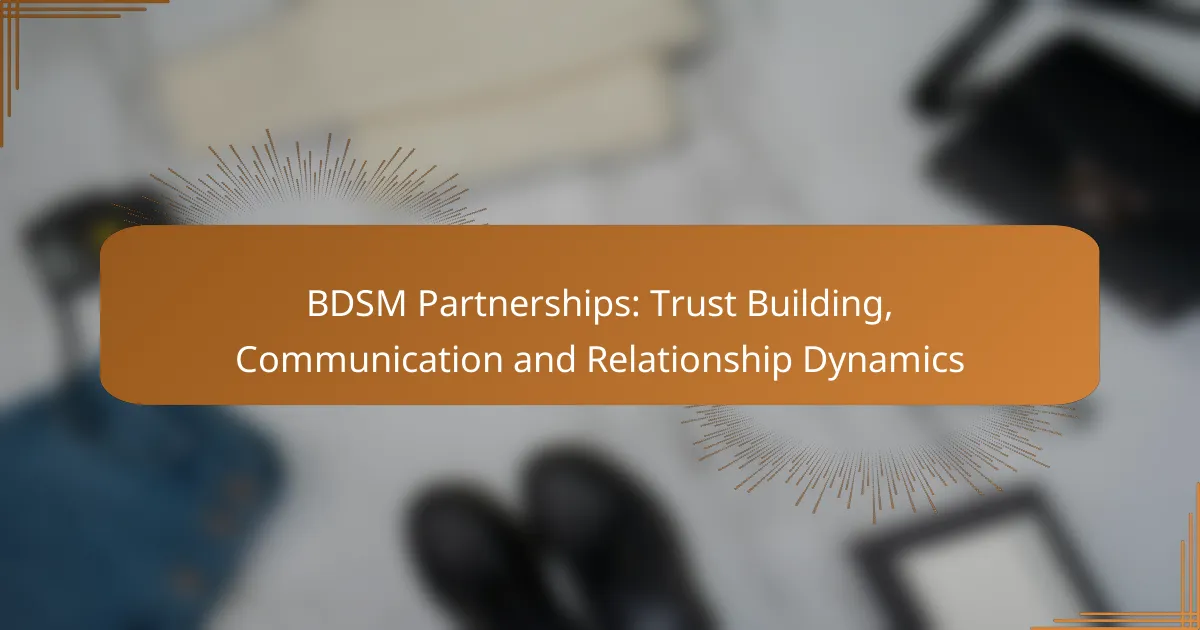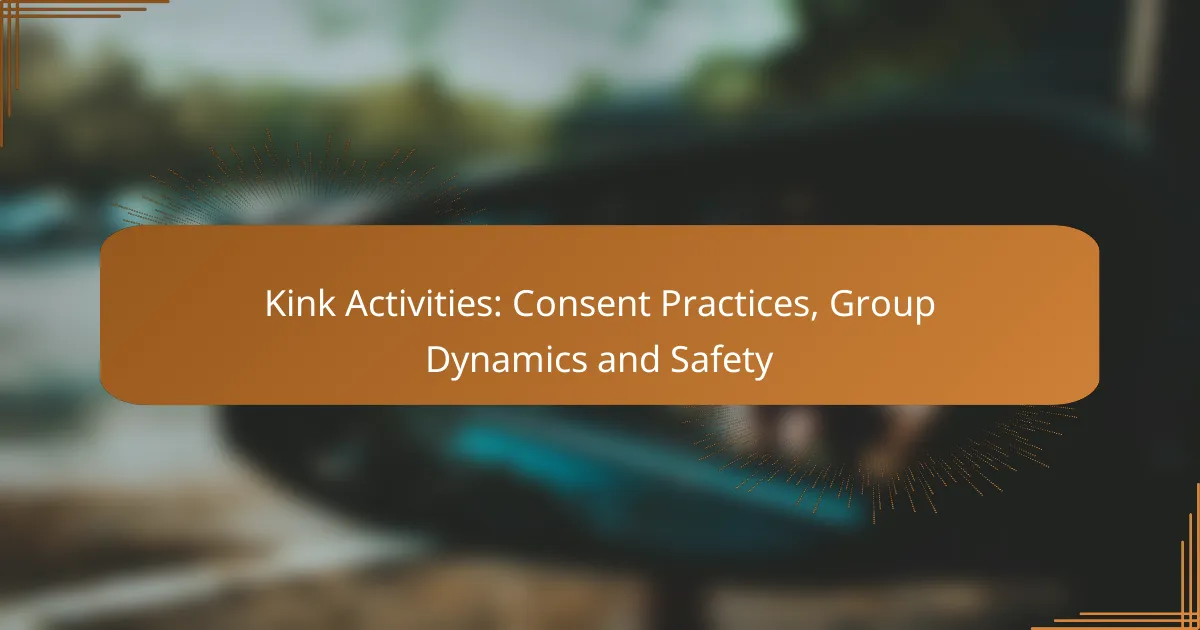[censured] partnerships thrive on a foundation of trust, safety, and open communication, allowing partners to explore their desires and boundaries with confidence. Effective communication strategies are essential for enhancing these relationships, ensuring that all parties feel secure and respected. By understanding the unique dynamics of power exchange and consent, partners can foster emotional intimacy and build a healthy, fulfilling connection.
![How to build trust in [censured] partnerships?](/wp-content/uploads/how-to-build-trust-in-[censured]-partnerships-1.webp)
How to build trust in [censured] partnerships?
Building trust in [censured] partnerships involves establishing a foundation of safety, respect, and open dialogue. This trust is crucial for both partners to explore their desires and boundaries comfortably.
Establishing clear boundaries
Clear boundaries are essential in [censured] partnerships to ensure that both partners feel safe and respected. Discussing limits regarding physical, emotional, and psychological aspects of play helps prevent misunderstandings and fosters trust.
Consider using a “safe word” system to easily communicate when a boundary is reached. This allows for immediate cessation of activities if either partner feels uncomfortable, reinforcing the trust between them.
Practicing open communication
Open communication is vital for maintaining trust in [censured] relationships. Partners should feel free to express their desires, fears, and experiences without judgment. Regular discussions about preferences and limits can enhance mutual understanding.
Utilize tools like journals or apps to track feelings and experiences related to [censured] activities. This can help partners articulate their thoughts and feelings more effectively during conversations.
Engaging in regular check-ins
Regular check-ins are a proactive way to maintain trust and ensure that both partners are comfortable with the dynamics of their relationship. Schedule these discussions after scenes or at regular intervals to assess feelings and boundaries.
During check-ins, ask open-ended questions about what worked well and what could be improved. This ongoing dialogue helps partners adapt to each other’s evolving needs and reinforces their commitment to each other’s safety and satisfaction.
![What communication strategies enhance [censured] relationships?](/wp-content/uploads/what-communication-strategies-enhance-[censured]-relationships-2.webp)
What communication strategies enhance [censured] relationships?
Effective communication strategies are crucial for strengthening [censured] relationships. Clear dialogue fosters trust, ensures safety, and enhances the overall experience for all parties involved.
Using safe words effectively
Safe words are essential in [censured] to establish boundaries and ensure that all participants feel secure. A safe word should be easy to remember and distinct from regular conversation, often chosen for its simplicity, such as “red” for stop and “yellow” for slow down.
It’s important to discuss and agree on safe words before engaging in any activities. Regularly revisiting these agreements can help maintain clarity and trust, ensuring everyone feels comfortable expressing their limits.
Active listening techniques
Active listening involves fully concentrating, understanding, and responding to what your partner is communicating. This can be achieved by maintaining eye contact, nodding, and summarizing what your partner has said to confirm understanding.
In [censured], active listening helps partners gauge comfort levels and emotional responses during scenes. Practicing this technique can prevent misunderstandings and enhance the emotional connection between partners.
Non-verbal communication cues
Non-verbal communication plays a significant role in [censured] dynamics, as it can convey feelings and reactions that words may not express. Body language, facial expressions, and even breathing patterns can indicate comfort or discomfort.
Being attuned to these cues allows partners to respond appropriately, adjusting the scene as needed. Regular check-ins, both verbal and non-verbal, can help reinforce understanding and safety in the relationship.
![What are the key dynamics of [censured] relationships?](/wp-content/uploads/what-are-the-key-dynamics-of-[censured]-relationships-3.webp)
What are the key dynamics of [censured] relationships?
[censured] relationships are characterized by unique dynamics that revolve around power exchange, consent, and emotional intimacy. Understanding these elements is crucial for fostering trust and ensuring a healthy partnership.
Power exchange principles
Power exchange is a fundamental aspect of [censured] relationships, where one partner (the Dominant) takes control while the other (the submissive) relinquishes it. This dynamic can vary widely, from temporary scenes to long-term arrangements, and requires clear boundaries and mutual understanding.
Establishing power exchange principles involves discussing roles, limits, and safe words. Both partners should agree on what is acceptable and what is not, ensuring that the experience is enjoyable and safe for everyone involved.
Role of consent in dynamics
Consent is paramount in [censured] relationships, serving as the foundation for trust and safety. All activities must be consensual, meaning that both partners have agreed to participate willingly and can withdraw consent at any time.
Practicing informed consent involves open communication about desires, limits, and potential risks. Regular check-ins and discussions about boundaries help maintain a healthy dynamic and ensure that both partners feel respected and valued.
Emotional intimacy factors
Emotional intimacy plays a significant role in [censured] dynamics, as it fosters trust and connection between partners. Engaging in [censured] activities can create a deep bond, but it requires vulnerability and openness from both parties.
To enhance emotional intimacy, partners should engage in aftercare, which involves comforting and supporting each other post-scene. This practice helps reinforce trust and allows partners to process their experiences together, strengthening their relationship over time.
![How to navigate conflicts in [censured] partnerships?](/wp-content/uploads/how-to-navigate-conflicts-in-[censured]-partnerships-4.webp)
How to navigate conflicts in [censured] partnerships?
Navigating conflicts in [censured] partnerships requires open communication and a commitment to understanding each partner’s needs and boundaries. Addressing issues promptly and constructively can help maintain trust and strengthen the relationship.
Identifying triggers and responses
Recognizing triggers is essential for managing conflicts in [censured] dynamics. Triggers can stem from past experiences, personal insecurities, or specific situations that evoke strong emotional responses. Partners should openly discuss their triggers to foster awareness and empathy.
Responses to triggers can vary greatly among individuals. Some may react with anger or withdrawal, while others might become anxious or defensive. Understanding these responses can help partners anticipate potential conflicts and address them proactively.
Conflict resolution techniques
Effective conflict resolution techniques are vital in [censured] partnerships. One approach is to use “I” statements to express feelings without placing blame, such as “I feel uncomfortable when…” This encourages a constructive dialogue rather than defensiveness.
Another technique is to establish a safe word or signal that either partner can use to pause discussions if emotions escalate. This allows for a cooling-off period, enabling both parties to return to the conversation with a clearer mindset.
Importance of aftercare
Aftercare is a crucial component of conflict resolution in [censured] relationships. It involves providing emotional and physical support to each other after a scene or conflict, helping to restore trust and connection. Aftercare can include cuddling, discussing feelings, or simply spending quiet time together.
Prioritizing aftercare can mitigate the emotional fallout from conflicts, reinforcing the bond between partners. Establishing aftercare routines tailored to each partner’s needs can enhance overall relationship satisfaction and resilience.
![What are the prerequisites for a healthy [censured] relationship?](/wp-content/uploads/what-are-the-prerequisites-for-a-healthy-[censured]-relationship-5.webp)
What are the prerequisites for a healthy [censured] relationship?
A healthy [censured] relationship requires clear communication, trust, and a mutual understanding of boundaries. Establishing these prerequisites ensures that all parties feel safe and respected while exploring their desires.
Understanding personal limits
Recognizing and articulating personal limits is essential in [censured] partnerships. Each participant should identify what they are comfortable with and what they are not, often referred to as hard and soft limits. Hard limits are non-negotiable, while soft limits may be explored under certain conditions.
Engaging in open discussions about these limits fosters transparency and helps prevent misunderstandings. Consider using a checklist to outline individual preferences and boundaries, ensuring everyone is on the same page before engaging in any activities.
Establishing mutual respect
Mutual respect is foundational in any [censured] relationship. It involves acknowledging each other’s boundaries, desires, and feelings. Participants should approach each other as equals, valuing consent and communication as cornerstones of their interactions.
Practicing active listening and validating each other’s experiences can enhance respect. Regular check-ins can help maintain this respect over time, allowing partners to adjust their dynamics as needed.
Prioritizing safety measures
Safety is paramount in [censured] practices, encompassing both physical and emotional aspects. Establishing safety measures includes discussing safe words, which provide a clear signal to pause or stop activities. Common safe words include “red” for stop and “yellow” for slow down.
Additionally, partners should consider using safety equipment, such as safety scissors for [censured] scenarios or first aid kits for potential injuries. Regularly reviewing safety protocols can help ensure that all participants feel secure and supported throughout their experiences.
![How do cultural perceptions influence [censured] partnerships?](/wp-content/uploads/how-do-cultural-perceptions-influence-[censured]-partnerships-6.webp)
How do cultural perceptions influence [censured] partnerships?
Cultural perceptions significantly shape [censured] partnerships by affecting attitudes toward consent, power dynamics, and the visibility of alternative lifestyles. These influences can determine how practitioners communicate their needs and establish boundaries within their relationships.
Impact of societal norms
Societal norms dictate what is considered acceptable behavior, which can influence how [censured] is perceived and practiced. In cultures with more conservative views on sexuality, [censured] may be stigmatized, leading practitioners to engage in these activities more discreetly. Conversely, in more open societies, [censured] may be more openly discussed and accepted, fostering healthier communication and trust among partners.
Communication styles
Cultural backgrounds can affect communication styles, which are crucial in [censured] partnerships. For example, cultures that value direct communication may encourage partners to express their desires and limits clearly, while those that emphasize indirect communication might lead to misunderstandings. Understanding these differences can help partners navigate their interactions more effectively.
Trust and consent
Trust and consent are foundational in [censured] relationships, influenced by cultural attitudes toward authority and personal autonomy. In cultures where individual rights are prioritized, consent is likely to be emphasized, allowing for clearer negotiations of boundaries. In contrast, cultures that prioritize hierarchy may complicate discussions around consent, making it essential for partners to actively work on establishing trust and clarity.
Legal considerations
Legal frameworks surrounding [censured] practices can vary widely by region, impacting how partnerships are formed and maintained. In some countries, [censured] activities may face legal scrutiny, while others may have protections in place for consensual practices. Understanding local laws is crucial for practitioners to ensure that their activities remain within legal boundaries and to foster a safe environment for exploration.

